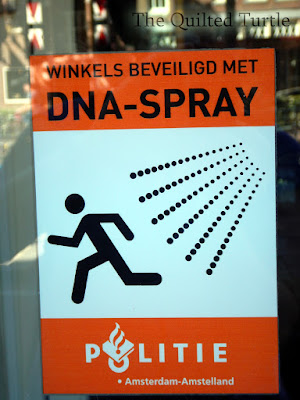On the map the Sloten windmill looks like it is way out of town, but it really isn't; it's only about eight miles from Amsterdam's Central Station. Not only is it within the city limits of Amsterdam, but it's the only windmill in Amsterdam that still pumps water and is open to the public.
To get there, we hopped on Tram One, at the corner near our house (Prinsengracht and Leidsestraat) and rode almost to the end of the line. From there we walked for about 15 minutes along a quiet canal to the Windmill. It took us maybe 30 or 40 minutes - including the walk.
To get there, we hopped on Tram One, at the corner near our house (Prinsengracht and Leidsestraat) and rode almost to the end of the line. From there we walked for about 15 minutes along a quiet canal to the Windmill. It took us maybe 30 or 40 minutes - including the walk.
Inside, the volunteers take you through just how windmills work. I didn't know each one can only lift water 1.5 meters (about five feet,) so typically a group of windmills worked together to keep a polder (an area of reclaimed land protected by dikes) dry. This particular area, which is about four meters below sea level (about 13 feet) use to have three windmills.
At the lowest level of the water-pumping mills there's an Archimedes' screw.
The screw connects to the sails (that move "anti-clockwise," by the way) by means of a system of wooden gears. They're lubricated with beeswax because according to our guide, Harry, the beeswax doesn't soak into the wood. The cogs were made to fit precisely; any other wax would cause the wood to swell and the cogs would no longer fit.

At full speed the Sloten windmill can pump over 60,000 liters (almost 16,000 gallons) of water a minute.
I found it interesting how the sails and main axle were built with an 18 degree tilt. According to Harry, the tilt is what holds all the moving pieces together; ingenious. Makes me wonder why 18 degrees - why not 17 or 19? How much trial and error did it take to figure out that measurement?

Not only was the windmill amazing to see in action, the view from the platform was spectacular. We could see some of the numerous canals surrounding the polder.
Of the over 10,000 windmills that operated in the Netherlands, most were replaced over the years by steam power and later electricity. Today only about 1,200 remain. Once a year the Netherlands celebrates National Mill Day. On the second Saturday in May many windmills around the country, that are not usually open to the public, open their doors to visitors. How fun would that be!
We loved visiting this windmill. Sure the attached Coopery Museum was a little kitschy, but it was created by and is completely staffed by volunteers. Our €20.00 entrance fee will go to help maintain this neat site and keep it open to the public. That makes me smile.


















































